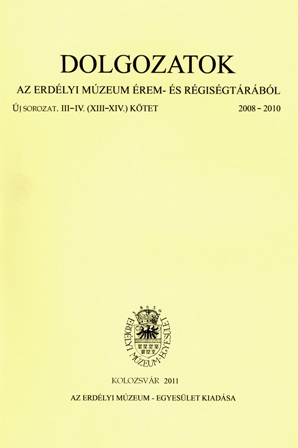„E könyv Rómer Flóris Ferencz váradi kanonoké”
“This Book Belongs to Flóris Ferencz Rómer, Canon of Várad”
A Chapter from the History of Hungarian Prehistoric Archaeology
Author(s): Erzsébet MartonSubject(s): History, Archaeology, Cultural history
Published by: Erdélyi Múzeum-Egyesület
Keywords: Flóris Ferencz Rómer; hungarian prehistoric archaeology; handwritten notebook; archaeological exhibition; artefacts
Summary/Abstract: Flóris Rómer’s (12th of April 1815, Pozsony – 18th of March 1889, Nagyvárad) 46 small handwritten notebooks, kept in the National Széchényi Library in Budapest, were partially published by several authors. This paper presents the notebooks XXXVIII-XLIV, focusing mainly on Rómer’s efforts on preparing the 8th International Congress of Anthropology and Prehistoric Archaeology (Congrès International d’Anthropologie et Archéologie Préhistoriques – CIAAP) held at Budapest between 3rd and 11th of September 1876. The congress was associated by an archaeological exhibition which presented the prehistoric finds from the Carpathian Basin. Due to the thorough organization, a great number or artefacts were exhibited, belonging to the Hungarian National Museum (9000 pieces) as well as to different county museums and particular collections (22000 pieces). At the same time the majority of the exhibited discoveries (31500 pieces) were collected by Rómer himself in the preceding years of the congress. At the 8th session of the CIAAP a lot of important researchers from all around Europe took part, like Sir Arthur Evans, Jens Jacob Asmussen Worsaae, Oscar Montelius, Konrad Leemans, Vilmos Lipp, János Kovács. In the frame of the congress nine sections were organized: 1. The characteristics of the earliest phase of human evolution; 2. The characteristics of the Neolithic stone tools; 3. Bronze Age; 4. Iron Age; 5. Barrow graves; 6. Fortified settlements; 7. Amber; 8. Ornaments (the section was not held); 9. Anthropological and ethnographical problems. One of the most important results of the congress was the introduction of the term of Copper Age in the scientific research, proposed by Ferencz Pulszky. Another important consequence of Rómer’s work was the presentation of the tell settlement from Tószeg-Laposhalom to the international research, which later became one of the most significant sites for the relative chronology of the European Middle Bronze Age.
Journal: Dolgozatok az Erdélyi Múzeum Érem- és Régiségtárából. Új sorozat
- Issue Year: 2010
- Issue No: III-V
- Page Range: 115-124
- Page Count: 10
- Language: Hungarian

